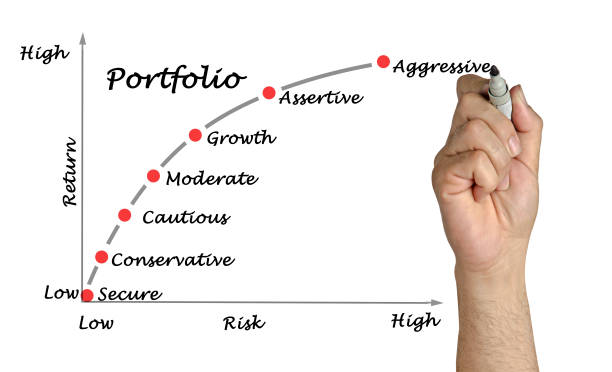
Introduction to Low Risk Portfolio
A low-risk portfolio helps beginners invest confidently, preserve capital, and generate steady returns while avoiding unnecessary stress. In this guide, we will explore what a low-risk portfolio is, the best options available in India, and how beginners can create one.
Every investor dreams of building wealth through the stock market or other financial instruments. However, beginners often face a common challenge: how to start investing without taking too much risk. For someone new to investing, safety and stability matter more than chasing high returns. That is where a low-risk portfolio becomes important.
What is a Low-Risk Portfolio?
A low-risk portfolio is an investment plan designed to protect your capital while earning stable returns. Instead of putting all money into volatile assets like equities, it balances investments across safer instruments such as fixed deposits, government bonds, and debt mutual funds, with limited exposure to equities for growth.
The goal of a low-risk portfolio is not to maximize profits but to minimize losses while ensuring steady wealth creation.
Key Characteristics of a Low-Risk Portfolio:
- Capital protection is the top priority.
- Returns are stable but moderate.
- Asset allocation includes a higher share of safe investments.
- Suitable for conservative investors and beginners.
Key Principles of Building a Low-Risk Portfolio
- Diversification – Never put all your money in one asset class. A mix of debt, equity, and gold reduces risk.
- Asset Allocation – Decide how much to invest in safe assets (like FDs, bonds) and how much in growth assets (like equities).
- Capital Protection First – Returns are important, but the first rule is to not lose your money.
- Regular Monitoring – Even a low-risk portfolio needs periodic reviews to ensure it matches your goals.
Best Low-Risk Investment Options in India for Beginners
Here are some of the most reliable choices for a beginner-friendly portfolio:
1. Fixed Deposits (FDs)
- Safe and guaranteed returns.
- Suitable for short to medium-term goals.
- Interest rates usually range from 6–7% depending on banks.
2. Public Provident Fund (PPF)
- Government-backed scheme with 15-year lock-in.
- Offers attractive interest rates with tax benefits under Section 80C.
- Perfect for long-term wealth creation.
3. Government Bonds & RBI Bonds
- Among the safest investments.
- Provide fixed interest income.
- Great for investors who want assured returns without market risk.
4. Debt Mutual Funds
- Invest in corporate and government debt instruments.
- Lower volatility compared to equity funds.
- Suitable for conservative investors with a medium-term horizon.
5. Index Funds / ETFs
- Offer exposure to top companies like those in the Nifty 50 or Sensex.
- Carry limited risk compared to individual stocks.
- Low cost and easy to invest through SIPs.
6. Balanced / Hybrid Funds
- Mix of debt and equity.
- Provide both safety and growth potential.
- Ideal for beginners who want some equity exposure with limited risk.
7. Gold (Digital or Sovereign Gold Bonds)
- Acts as a hedge against inflation.
- Adds diversification to the portfolio.
- Sovereign Gold Bonds also provide interest income.
Sample Low-Risk Portfolio Allocation for Beginners
A balanced low-risk portfolio could look like this:
- 50% Debt Instruments – Fixed Deposits, PPF, Government Bonds.
- 30% Equity (Low-risk exposure) – Index Funds or Large Cap Mutual Funds.
- 10% Gold – Sovereign Gold Bonds or ETFs.
- 10% Liquid Funds or Cash – For emergencies.
This allocation ensures safety, steady returns, and some growth exposure without taking excessive risks.
Mistakes Beginners Should Avoid
- Putting All Money in One Product – Diversification is key. Don’t rely only on FDs or only on equities.
- Chasing Quick Profits – Avoid risky stocks or speculative trading.
- Ignoring Liquidity Needs – Always keep some part of your portfolio in liquid instruments for emergencies.
- Not Considering Inflation – Choosing only fixed returns may not beat inflation in the long term.
- Skipping Research – Even safe investments need basic research before investing.
Steps to Create Your Own Low-Risk Portfolio
- Define Your Financial Goals – Are you saving for an emergency fund, education, or retirement?
- Assess Your Risk Tolerance – As a beginner, stick to safer investments first.
- Start with SIPs – Systematic Investment Plans in index funds or balanced funds are beginner-friendly.
- Mix Debt and Equity – Avoid going 100% into either. Balance ensures safety and growth.
- Review Annually – Rebalance your portfolio at least once a year to maintain the right allocation.
Advantages of a Low-Risk Portfolio for Beginners
- Peace of Mind – Less stress and anxiety compared to high-risk investing.
- Stable Growth – Provides consistent, moderate returns.
- Best for Learning – Helps beginners understand investing without big risks.
- Capital Protection – Ensures money is safe while you learn.
Limitations of a Low-Risk Portfolio
- Lower Returns – You cannot expect very high profits.
- Inflation Risk – If you only stick to debt products, inflation may reduce purchasing power.
- Limited Growth – Compared to aggressive equity portfolios, wealth accumulation may be slower.
Conclusion
Creating a low-risk portfolio as a beginner is the smartest way to enter the world of investing. It helps you protect your capital, gain confidence, and learn the basics of financial planning. By diversifying between debt, equity, and gold, beginners can enjoy stability and steady growth.
Over time, as your financial knowledge and confidence grow, you can gradually add more equity exposure to aim for higher returns. Remember, investing is not about quick profits but about building long-term wealth with discipline and patience.
At Catchy Capital, we believe every beginner deserves a strong foundation. A low-risk portfolio is the first step toward achieving your financial goals with safety and confidence.




